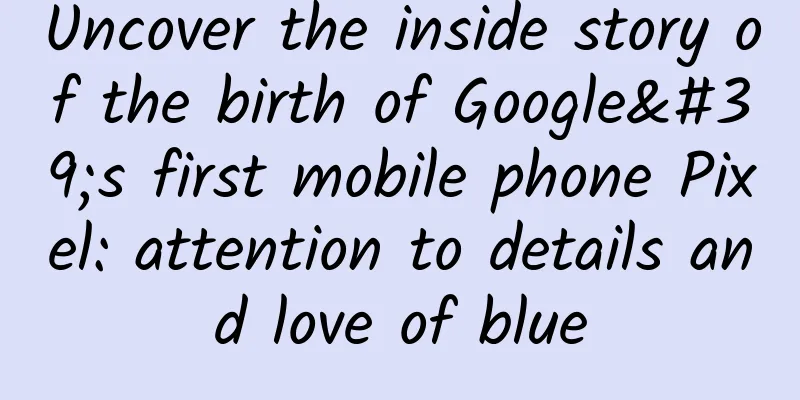Uncover the inside story of the birth of Google's first mobile phone Pixel: attention to details and love of blue

|
According to CNET, Google Pixel is Google's first smartphone designed and developed entirely in-house. It's like a phone tailor-made for Goldilocks, and must abide by her rules, that is, everything must be done in moderation and not beyond the limit. To achieve this goal, you need to pay attention to details and a dedicated team that loves the color blue. Since 2010, Google has been working with Samsung, LG, Motorola and other companies to build its own brand of smartphones that can run its mobile operating system Android. This phone is called the Nexus series of phones, and the hardware devices made by the above smartphone manufacturers for Google can run the latest version of the Android system. But five years later, when it launched the Nexus 6P in cooperation with Huawei, Google changed its mind and decided to independently develop and produce a new phone without cooperating with manufacturers. Although other companies can still assemble Google phones, Google will develop, design and sell it alone. Designing the Pixel, however, can be like building a phone for Goldilocks. It has to have high-end hardware without compromising on style. It has to appeal to the masses without disappointing loyal users. It needs to be visually distinctive without being too garish. In other words, it has to look just right. All the right curves in all the right places Since the launch of the Nexus One, the Nexus brand has attracted a large number of Android loyal users who are eager for a more powerful phone that can be customized. They are the most loyal users of Google phones, but their number is not large. With Pixel, Google hopes to attract more loyal users than the Nexus series, and the target audience is no longer limited to "techies." To achieve this goal, its new phone must give people the impression that it is more like an old friend than a machine. Brian Rakowski, vice president of software product management at Google, said that most people don't want their phones to look scary. "You want your phone to be something that helps you, you can trust it, and use it to do things for you," he said. To make the Pixel look less aggressive, we first need to soften its corners and make the edges more rounded. Contour corners seem more popular and easier to attract people's attention, but sharp corners seem more aggressive and can easily alienate users. Even if the corners of the phone are curved, the curvature cannot be too large. After studying how people hold and carry their phones, the Google mobile team determined the "chamfered curve", which is very comfortable to hold and makes the Pixel look slimmer. There is one curve that Google's industrial design team wanted to avoid, however, and that's around the camera lens. Designing a phone without a camera bump wasn't a priority for the team, but they might get a bonus if they can avoid it. Besides being unsightly, the camera bump makes it difficult to lay the phone flat on a smooth surface. But the Pixel's camera sensor could be a problem, as it's too large, and while that lets in more light, it still needs to fit into the Pixel's slim form factor. To this end, the design team reworked the Pixel's profile. By thickening the top half and making the bottom thinner, they could keep the camera they wanted, avoid the bulge, and fit in a larger battery. Jason Bremner, Google's vice president of mobile product management, said: "We want to keep the sensor, but we don't want to compromise it. Because it's wedge-shaped, this design can be suitable for installing a larger battery, killing two birds with one stone." Color detail trouble In 2008, Jared Spool, founder of Massachusetts-based company User Interface Engineering, wrote: "When good design is done to an extreme, it becomes unnoticeable. It is only when it is bad that we pay attention to it." For the Pixel's design team, this means paying attention to every detail, even if people don't notice it. As long as users feel that the overall design of the phone is good, it can still be considered a design success. However, there are a lot of details to pay attention to. "A lot of times, people may not notice these details, but they appreciate the well-designed device," said Rachael Roberts, an industrial designer on the team. For example, the Pixel's textured power button is located on the right edge of the phone. The design team tried many different groove options before settling on the final design. Generally, the groove helps you locate the button just by feel, while distinguishing it from the volume control button. The design team carefully chose something that was not too rough, but they also knew that something too smooth would not make sense. After several iterations, including placing diagonal lines and triangles in different patterns, Google finally chose a diamond profile pattern. The design team placed a glass panel on the back of the Pixel, where it's equally inconspicuous. The panel itself is easy to spot, as it gives the phone a distinctive two-tone look that makes it look like it's made of glass and aluminum. It also has functional benefits, giving the phone six antennas, more surface area to receive and send signals. But underneath the glass panel on the blue and silver versions of the Pixel, there's a film that makes the glass reflect a soft yellow hue. This is called the "two-tone effect," and it's similar to the naturally colorful sheen of soap bubbles. You've probably come across art, jewelry, and architecture that use the two-tone glass effect. The yellow reflection was added for purely aesthetic reasons. The black Pixel didn't use this design mainly because it didn't look pretty enough. Similarly, the sandblasted finish on the black Pixel's aluminum casing has different finishes. Where the blue and silver have a smooth feel, the black feels rough. The reason? Again, purely aesthetic. "We felt that a smooth finish would work better on the blue and silver Pixels, but the black would look just as cool," Villarreal said. It's not often that a design team lets their gut drive their decisions. But sometimes, that's just the way things work. You bring in focus groups, you do research. But at the end of the day, if it feels right, you have to trust your gut. Feel the "True Blue" Most phones come in black. Sometimes, phone makers release white or silver versions. Occasionally, a one-off color is released, like a gold iPhone 5S or a fiery red Nexus 5. These fun "pop colors" are useful for promoting phones, and they often sell out quickly, partly because of the novelty but also because the manufacturer can only make a limited number of them. Pixel also has its own display color, which is simply called "Really Blue". Like Very Silver and Quite Black, this name is a tongue-in-cheek reference. Since Google's marketing team overuses color names such as Ocean Blue, Graphite, Slate, etc., the product team doesn't seem to be too impressed when hearing such names. "We all agreed that this name was lame," said Lekowski, Google's vice president of software product management. The marketing team tried a variety of approaches, including more ironic and self-aware ones, before finally settling on the name. "It definitely feels on-brand, and we like to poke fun at ourselves a little bit," Lekowski said. Agreeing on the name was one thing; choosing the specific color of the phone was another, requiring collective wisdom. In the quest for the perfect showcase color, the design team brought in focus groups to evaluate samples and mockups of different colors. We came up with dozens of colors, including emerald green, gray-purple, deep yellow, and a delicate baby blue. But it was clear that the jewel-tone deep blue was the favorite, resonating with people of different genders and ages. Of course, they needed more fine-tuning, which would require more focus testing and more mockups. But the design team also needed to consider their own tastes. "It wasn't easy to find the right color, and we went through a lot of trial and error," Villarreal said. "When we first saw the color we chose, it was like, 'This is it,' there's just so much energy in it." Depending on the light, the blue Pixel can range from a bright royal blue to a rich cobalt blue. While it's often seen as Google's safe brand color, it can still cause tricky questions if not chosen correctly. Joann Eckstut, color consultant and collaborator at The Secret Language of Color, says blue is unique among polarities. It represents the working class (blue collar) and the wealthy (blue blood), it is ubiquitous in the sky and ocean, but hard to find in nature. And while it is largely seen as a masculine color today, it was a feminine color until the 1940s. Ultimately, the name Really Blue was chosen. It's just the right shade of blue so as not to scare away potential buyers. "To me, it means something rare and unique, made just for unique people," Exter said. Prepare for huge success When Google finally unveiled the Pixel in San Francisco in October 2016, it had no idea what to expect. The phone had been in internal testing for more than half a year, and the team was nervous. What would users think? Had they overlooked something? Was there room for improvement? "Sometimes when you're close to launching a product, you get nervous," says Bremner, Google's vice president of product management for phones. "The more you look at the details, the more you see what you could, should, and would do." There's no guarantee that the Pixel will please every Goldilocks fan, with some observers arguing that the design borrows too much from other products, like Apple's iPhone or its own manufacturers. But Google did everything it could to create a phone it can proudly call its own. From tweaking button textures to avoiding cliché names to making sure the yellow reflections didn't clash with the specific color of aluminum, the Pixel is a combination of Google's ambition and experimentation. As Bremner puts it: "It took a lot of trial and error. To be honest, building a phone is all about compromise, it's about balancing the pros and cons to find the 'sweet spot'!" As a winner of Toutiao's Qingyun Plan and Baijiahao's Bai+ Plan, the 2019 Baidu Digital Author of the Year, the Baijiahao's Most Popular Author in the Technology Field, the 2019 Sogou Technology and Culture Author, and the 2021 Baijiahao Quarterly Influential Creator, he has won many awards, including the 2013 Sohu Best Industry Media Person, the 2015 China New Media Entrepreneurship Competition Beijing Third Place, the 2015 Guangmang Experience Award, the 2015 China New Media Entrepreneurship Competition Finals Third Place, and the 2018 Baidu Dynamic Annual Powerful Celebrity. |
Recommend
Has Su Dongpo, who “ate 300 lychees a day”, ever eaten Sichuan lychees?
As we all know, the great writer Su Dongpo was a ...
Fitness video - Women who lift weights are the most beautiful (31 episodes 1.39G)
Fitness Video - The most beautiful woman who lift...
I know about mud and I know about volcanoes, but what is this "mud-spewing volcano"?
In 2011, on Russia's Sakhalin Island, a photo...
Breaking news! The U.S. Department of Commerce has ordered a ban on downloading TikTok and WeChat starting on the 20th. TikTok objects: Will proceed with the lawsuit
Finally, the United States made a decision - to i...
Online promotion channels for product operation and promotion plans!
In the mobile Internet industry, the market for g...
The Taklimakan Desert is getting wetter! Why is rainfall in southern Xinjiang becoming more frequent?
On August 27, the topic #新疆塔克拉玛干漠发Flood# ranked f...
Why does ofo invest in advertising while Mobike does public relations?
To date, ofo and Mobike have been fighting for ne...
What is https for a website and why should we use it?
Since the epidemic period, online promotion has b...
Luo Yao's Graphic Design Thinking Course ended in March 2020 [HD video only]
Luo Yao's Graphic Design Thinking Course ende...
Google Talk, once a favorite among programmers, will be shut down next week
Google Talk, which was once very popular among pr...
One fall can cost you hundreds of millions! Why are wealth-showing challenges so popular on social media?
Recently, a wave of nationwide challenges has bee...
Winter limited return in some areas? Sandstorm, snowstorm, thunder and cold are coming, please remember to put on more clothes in time!
This week, the weather across the country has bee...
With these three things on, your content can be as sexy as an influencer!
"Life is short, you must be sexy", in f...
Bluetooth 5.0 and Wi-Fi, which one is better for the Internet of Things?
The Bluetooth SIG’s announcement of Bluetooth 5 i...





![[Popular Science of Chinese Military Technology] As the "King of Rolls" among cruise missiles, what are the outstanding features of the Haiyan nuclear-powered cruise missile?](/upload/images/67f225be78d01.webp)



